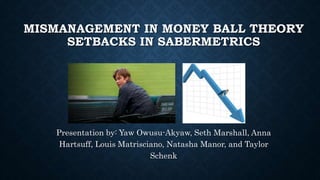
Mismanagement in money ball theory (4)
- 1. MISMANAGEMENT IN MONEY BALL THEORY SETBACKS IN SABERMETRICS Presentation by: Yaw Owusu-Akyaw, Seth Marshall, Anna Hartsuff, Louis Matrisciano, Natasha Manor, and Taylor Schenk
- 2. PRESENTATION OBJECTIVE • Presentation Objectives • Display how the sabermetrics failed to support recruiting decisions. • Reveal the ineffective aspects of the General Manager’s decision-making methods. • Explain how managerial decision led to adverse psychological impacts. • Unveil the lack of fairness used in the recruitment process. • Critique the minimum qualifications the level reliability.
- 4. OVERRELIANCE ON STATISTICAL DATA TO CREATE MEASUREMENT SYSTEM The Measurement process evaluates employees potential to perform task related to an organization’s overall goal. Situation: The General Manager use the players’ statistical playing attributes to measure (OBP) potential. Problem with Measurement System: - Managerial decisions are solely influenced by the numbers generated from the measure. - Fails to recognize external factors affecting performance • (Experience, Cognitive Reasoning, Motiviation, Personality, etc.) Attribute of Interest: Baseball Runs Operational Definition of Attribute: On-Base-Percentage Measure: Sabermetrics Measure’s Administration Method: Practice and Games How Measure is Evaluated: Number of Runs made by player Unable to provide the full picture of players/employees.
- 5. MEASUREMENT’S NEGATIVE EFFECTS ON MANAGEMENT • Mismatching positions due to heavy reliance on numbers rather than experience. • Creating recruiting decisions that counter the goal of the measurement process. • Forecasting future performance solely on the numbers displayed for short duration of to time. • Example one: General Manager attempts to place a former pitcher as the team’s first-baseman. Role ambiguity causes a decrease in player’s performance and confidence. • Example two: Statics leads management team to use three players to replace one effective player. Data should have been used to find one player that matched to the former athlete's ability.
- 8. DECISION MAKING • Predictors were solely based on money and past performance. • Low face validity, some players didn’t understand why they were recruited i.e. a catcher being recruited to play first base. • Very narrow focus which had a negative impact on the team
- 9. DECISION MAKING • The predictive selection hypothesis was the sole focus of the recruiting efforts. If the statistics and price lined up the players were recruited. • Experience and mostly intuition were the focus of Billy Bean. • Unreliable and not measureable.
- 10. DECISION MAKING PROCESS • Beane disregards Clinical prediction • Expertise of scouts • Experience of the manager • Predictors are overly related • Don’t take into account other predictors • Predictors should be more independent • Would be a better predictor of success
- 12. PSYCHOLOGICAL CONTRACTS • Transactional Contracts • Beane largely held psychological contracts that were transactional in nature. • Narrow involvement – makes decisions without input • Low commitment – manager doesn’t listen to Beane • Relational Contracts • Beane should have developed psychological contracts that were relational in nature • Mutual loyalty – manager would have considered Beane’s thoughts • Higher commitment – manager and scouts would have went beyond minimum • Open-ended collaboration
- 13. RECRUITMENT & FAIRNESS PERCEPTIONS • Distributive Fairness-Perception of fairness of hiring outcome • Procedural Fairness-Perception of fairness of organization’s policies and procedures • Interactional Fairness-Perception of information and personal treatment given during hiring process. Billy Beane’s methods could have led to Spillover Effects: Recruitment tactics used to hire Scott Hatteberg The poaching of Peter Brand from the Cleveland Indians
- 14. BILLY BEANE AS A RECRUITER AND GENERAL MANAGER Ineffective Characteristics: • Poor Interpersonal Skills • Angry rages after losses including throwing things, screaming and damaging property • Pointing and snapping at Peter Brand during a meeting to relate data and figures without introducing him to the rest of the scouts as a new employee • Lacks Warmth • Isolates himself from players and team in general and refuses to attend games • Terminates players with his “bullet to the head” method and does not express any sympathy
- 15. BILLY BEANE: THE NO-SHOW! Other Ineffective Characteristics: • Too focused on the “goals game” • Prematurely resolves tension • Refuses to accept solutions from his scouts, even when he had no solutions himself (at the time) • A strong focus on individual games (instead of the season as a whole) • Can lead to emotional (bad) decision making!
- 17. DETERMINING MINIMUM QUALIFICATION • But only by changing the categories were the A’s team able to afford players that would show results • Instead of increasing or decreasing the high and low cut scores the team looked for different skills • This is how they then determined the level of satisfaction and dissatisfaction in performance x x x x x x x x x x x x x x x x x x xx x x x x x x x x x x x x x x x x x x x x x x x x x xx x x x false positive false negative true negative true positive
- 18. RELIABILITY OF METHOD • Sabermetrics was not meant to be successful in a short 7 game series but in a 160+ game season • When comparing the traditional stats of each player Beane’s team would be ranked the lowest in baseball history
- 20. REFERENCES